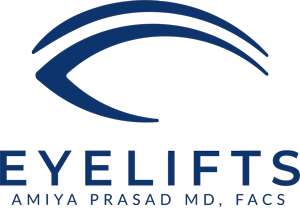For under eye concerns such as hollowness, deep tear troughs, and mild under eye bags, the versatility of eye fillers can be of great benefit.
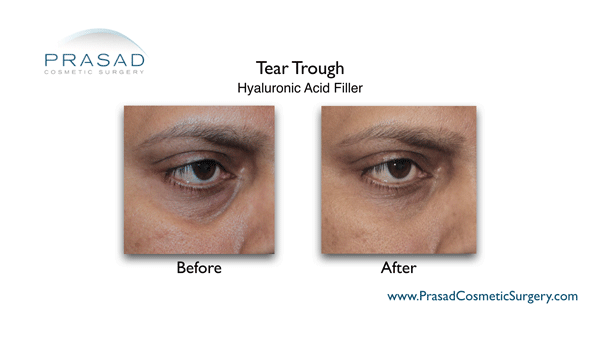
Softer hyaluronic acid fillers like Restylane or Juvederm Ultra work best for addressing hollow under eyes.
What Causes Hollow Eyes and Tear Trough?
Under eye hollowness can manifest in a small area directly under the eyes called the tear trough, and in other cases can affect larger areas that encompass the upper cheeks, too. Under eye hollowness can be caused by age-related volume loss or be a simple case of genetics, and can be exacerbated by excessive sun exposure and habits like smoking.
What is the Best Treatment for Under Eye Hollows?
Due to the thinness of lower eyelid skin (0.5mm), softer hyaluronic acid fillers such as Restylane, Restylane Silk, and Juvederm Ultra are used to treat under eye hollowness. Less viscous fillers like these can be more easily sculpted into the under eye region, and move flexibly under the skin so they don’t affect the appearance of the eyes in the way that thicker fillers or implants do.
Softer hyaluronic acid fillers can be administered in just a few minutes, and typically last for about 4-6 months, depending on how fast one’s body metabolizes the material.
An added benefit of hyaluronic acid fillers is they can be reversed with the help of hyaluronidase, an injectable enzyme that can dissolve them instantly. Since the primary material of hyaluronic acid occurs naturally in the body, it is hypoallergenic and can be safely metabolized and reabsorbed by the body.
What is PRP and How Does it Improve Eye Filler Results?
Platelet-Rich Plasma (PRP) is a concentration derived from the patient’s own blood. A blood sample is taken, then spun in a centrifuge to isolate the plasma concentration that contains growth and healing factors essential for wound healing.
PRP is known to help stimulate new collagen, stimulate the creation of new blood vessels, and improve circulation. Thus, when addressing under eye discoloration and pigmentation concerns, Dr. Prasad routinely combines PRP with cosmetic filler in order to improve overall skin quality, color, volume, and to potentially extend the effect of the filler as well.

Combining PRP with cosmetic filler helps improve skin texture, quality, thickness, and even prolongs the effects of the hyaluronic acid filler.
Inadequate Volume in Cheeks can Cause Under Eye Hollowing
In many cases, hollow under eyes can be caused by a volume deficiency and volume difference in the upper cheeks caused by the presence of a natural asymmetry or age-related volume loss. As such, placing filler in the tear trough area is not enough because of the lack of cheek volume to support it.
To address this, volume can be added into the cheeks. Since the skin of the cheeks is much thicker than the lower eyelid and tear trough area, and because the cheekbone provides more substantial support, a thicker hyaluronic acid filler like Juvederm Ultra Plus or Juvederm Voluma can be used.

Under eye hollowness can be caused by volume loss in the cheeks, which can be corrected via a procedure called Structural Volumizing/ Y Lift®.
A specialized technique called Structural Volumizing, or the Y Lift® method, is also employed. Using the aforementioned thicker hyaluronic acid fillers, volume is added into the deeper structural levels of the face, on top of the bone and under the muscle. This addresses bone loss due to aging and provides better foundational volume, which in turn gives the face better definition and angularity.
Adding filler at the deeper levels is significantly better than injecting it into the superficial layers of soft tissue, as it is typically done. By doing this, you avoid that doughy or pillowy appearance because the weight of the filler is supported by the bone itself, and kept in place by the muscle. An added benefit is that thicker fillers will also last much longer — about 1-2 years.
Fat transfer is another method one can consider for cheek volume enhancement. However, as previously mentioned, fat tends to be unpredictable and inconsistent, and requires a number of complex surgeries to complete. It can also become quickly reabsorbed by the body.
Filler Treatment for Under Eye Bags
Eye bags is one of the most popular cosmetic concerns, particularly among younger people whose primary complaint is often how eye bags tend to make them look tired or older than they are. As such, cosmetic fillers have become one of the most sought after treatments in cosmetic medicine, due to its convenience, the immediacy of results, and minimal invasiveness.
Do Fillers Work for Bags Under Eyes?
In contrast to the beliefs of other doctors who say that all eye bags can be treated with filler, Dr. Prasad understands that this is only true in certain cases. Mild under eye bags can be addressed with filler, but severe under eye bags require a different approach altogether. Oftentimes, attempting to camouflage heavy under eye bags with filler tends to exaggerate the volume already present, thus making the puffiness worse.
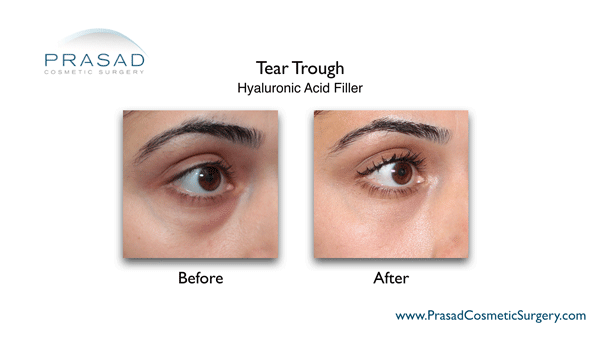
Mild under eye bags can benefit from filler treatment injected into the transition between the hollow tear trough and the puffy eye bag.
When treating mild under eye bags, filler is typically injected into the tear trough area. The hollowness of the tear trough area can often make eye bags appear larger or heavier — much like how a valley situated next to a mountain can make the mountain look bigger.
So, by filling this hollow area, the puffiness is likely not to look as prominent, though this only works on mild under eye puffiness. Doing this on much more severe eye bags will only contribute to the severity of the puffiness.
In cases where the under eye area is overfilled, often causing the eye bags to look bigger, an enzyme called hyaluronidase can come in handy to remove excess volume by dissolving unwanted filler. When the original anatomy has been restored, one can consider undergoing surgery to sculpt and remove the excess fat causing the puffiness, or have filler placed again when appropriate.
Fillers for Volume Enhancement After Eye Bag Surgery
In some cases, even when eye bag removal surgery is done correctly and the fat pockets are sculpted properly, certain adjacent areas may still appear hollow, and will need additional enhancement. These areas include the junction between the eye and cheeks, the upper cheeks, and the orbital rim of the eye socket.
The cheeks can be addressed with the help of a thicker filler like Juvederm Voluma or Juvederm Ultra Plus, while the orbital rim and tear trough will benefit from softer fillers like Restylane, Restylane Silk, or Juvederm Ultra.
Considerations for Eye Fillers or Surgery for Under Eye Bags
Fillers are Temporary and Require Maintenance
It is important to understand that periodic maintenance will be needed once you decide to go down the filler path. Softer under eye fillers usually last anywhere from 3-6 months, depending on how fast one metabolizes them. Softer fillers which are used for the under eye area may not last as long as thicker, harder fillers, and can become metabolized quicker, particularly since the primary ingredient of these fillers is hyaluronic acid which occurs naturally in the body.
Injectable Fillers as Invasive Treatments
Many people opt to undergo filler treatment in order to avoid surgery. Interestingly, filler injections are actually just as invasive as surgery, because you’re essentially penetrating the skin with a needle.
When it comes to addressing eye bags, Dr. Prasad routinely uses the transconjunctival method. A transconjunctival blepharoplasty is a specialized procedure that involves making an incision on the inside of the lower eyelid, through which the fat pockets are either removed, repositioned, or sculpted.
In contrast to the more common transcutaneous blepharoplasty which involves making an incision on the outside of the eyelid, the transconjunctival blepharoplasty leaves no external incision, leaving no chance for a visible scar.
In addition to this, the transcutaneous method is more likely to result in eyelid complications such as eyelid retraction (pulled-down eyelids) and ectropion (everted lower eyelids) as the nature of the procedure can undermine the support structures of the lower eyelid.
Recovery Periods for Injectable Fillers vs Eye Bag Surgery
Bruising is a common occurrence after injectable fillers, though rarely in Dr. Prasad’s practice. The bruising, however, is temporary. The recovery period for both filler treatment and transconjunctival blepharoplasty usually takes about one week as Dr. Prasad exclusively performs this surgery with local anesthesia with LITE™ sedation.
The major difference of a transconjunctival blepharoplasty is that it yields results that lasts for years, in contrast to fillers, which require repeated maintenance sessions and repeated recovery periods.
Why Fat Transfers are Not Advised for Lower Eyelids
Many people share the common perception that lower eyelid hollowing is best addressed by means of a fat transfer using one’s own fat. The thought behind this is that because fat is naturally-occurring in the body, it should be safe. There are, however, a number of reasons why a fat transfer for lower eyelid hollowing is not recommended.
Fat is quickly absorbed by the body. After the transfer, as much as 30-70% of fat can be reabsorbed by the body, thus requiring additional volume enhancement.
Fat is texturally inconsistent. This can lead to visible lumps and bumps after the transfer.
Fat requires readily available blood supply. If the area has an inadequate supply of blood, complications can occur, and the fat will need a complex surgical removal.
Fat transfer requires extensive surgeries. A fat transfer requires one surgery for the harvesting of fat, and then another surgery for placement of fat. Maintenance, or “touch ups” also require surgery. In the event that the fat doesn’t take properly, surgery will also be required in order to remove it.
This is all in stark contrast to hyaluronic acid fillers, which do not require surgery for placement or removal.
Fat Transfer for Upper Eye Hollowness
Fat transfers can be performed in areas of the face with thicker skin, such as the sub-brow area above the upper eyelids. This area may have hollowed if excessive fat was excised in aggressive Asian double eyelid surgery. It is important to note that for any fat grafting procedure that 30-70% of fat can be reabsorbed by the body, so needing a follow up procedure is common.
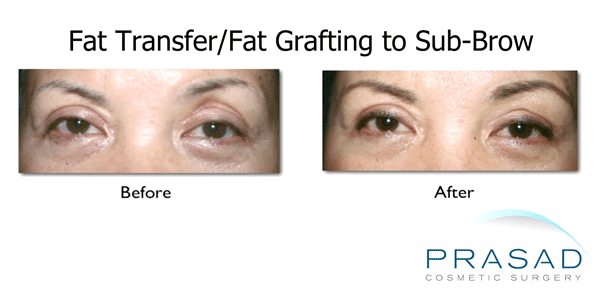
Fat transfer/ fat grafting can be done on the thicker skin of the sub brow to correct volume loss in the hollow, arched area above the upper eyelid.
Fillers for Upper Eyelid Hollowness
A cosmetic filler with Restylane or Juvederm’s consistency can be applied to the upper eye area. This is also the treatment for cases of too much soft tissue was incorrectly removed by a non-specialist eyelid surgeon.
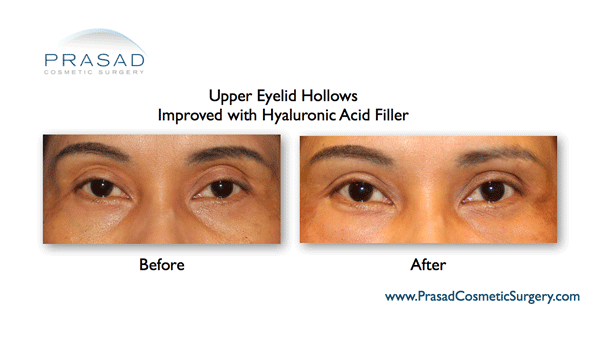
Upper eyelids were hollowed from previous surgery when too much fat was removed. Hyaluronic acid fillers like Restylane or Juvederm are more appropriate in the thin skin of the upper eyelids.
View upper eyelid filler before and after photos
Dr. Amiya Prasad, New York Oculoplastic Surgeon
Consult with us to discover the best treatment for your upper or lower eyelid issues. You may contact us by filling out the contact form below, and we’ll get back to you. You may also reach out to our Manhattan, New York City offices at (212) 265-8877, and our Garden City, Long Island offices at (516) 742-4636.
Post Reviewed by: Dr. Amiya Prasad
